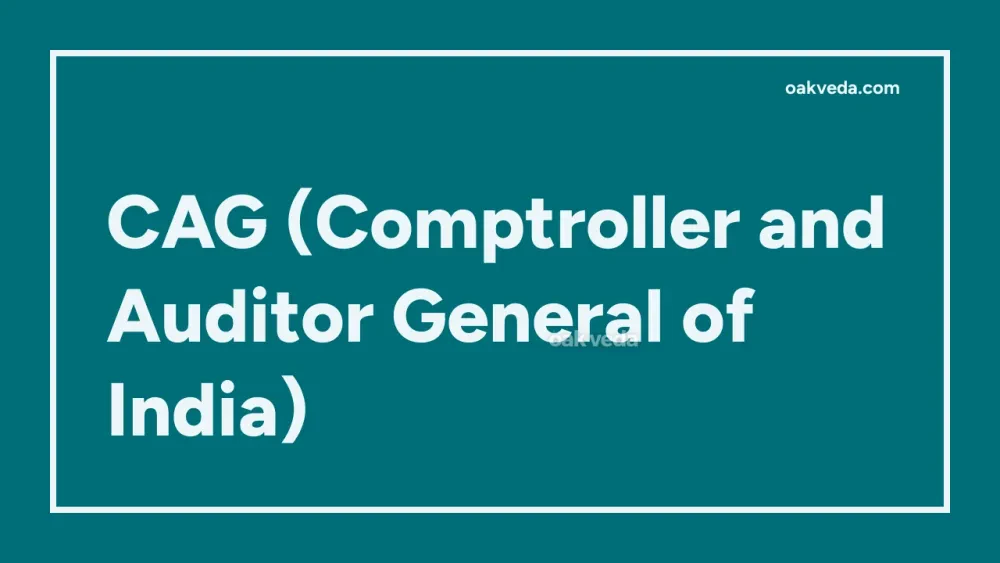
What is the Full Form of CAG?
The full form of CAG is Comptroller and Auditor General of India. This constitutional authority plays a crucial role in maintaining financial accountability and transparency in the Indian government.
What is Comptroller and Auditor General of India?
The Comptroller and Auditor General of India is a high-ranking official responsible for auditing all receipts and expenditures of the Government of India and the state governments. Established under Article 148 of the Indian Constitution, the CAG is an independent authority that ensures fiscal responsibility and accountability in public spending.
Origin and Development of Comptroller and Auditor General
The concept of CAG in India has its roots in the colonial era, but it gained constitutional status after independence. The role has evolved significantly since then, adapting to the changing needs of governance and financial management in the country.
How does Comptroller and Auditor General work?
The CAG operates through a network of offices across India, with its headquarters in New Delhi. It conducts audits, prepares reports, and submits findings to the President or state Governors, who then present these reports to the Parliament or state legislatures.
Functions of Comptroller and Auditor General
The CAG performs several critical functions:
- Auditing government accounts at central and state levels
- Examining public expenditures for efficiency and effectiveness
- Scrutinizing the accounts of government companies and corporations
- Providing insights on financial management to improve governance
Applications of Comptroller and Auditor General
The work of CAG has wide-ranging applications:
- Policy Improvement: CAG reports often lead to policy reforms and improved governance.
- Corruption Prevention: Regular audits help deter financial malpractices.
- Public Awareness: CAG reports inform citizens about government spending.
- Legislative Oversight: Parliamentarians use CAG reports for holding the executive accountable.
Features of Comptroller and Auditor General
Key features of the CAG include:
- Constitutional Authority: Enshrined in Article 148 of the Indian Constitution
- Independence: Operates autonomously from the executive branch
- Wide Jurisdiction: Audits central, state, and union territory finances
- Tenure Security: Fixed 6-year term or up to 65 years of age, whichever is earlier
Benefits of Comptroller and Auditor General
The CAG brings numerous benefits to Indian governance:
- Enhances financial accountability in public institutions
- Promotes transparency in government spending
- Aids in detecting and preventing financial irregularities
- Provides valuable insights for policy-making and resource allocation
- Strengthens democratic processes through financial oversight
Limitations or Challenges of Comptroller and Auditor General
Despite its importance, the CAG faces several challenges:
- Limited Enforcement Power: CAG can only report findings, not enforce actions
- Delayed Reporting: Sometimes, audit reports are released after considerable time lags
- Resource Constraints: Inadequate staffing and technological resources can hinder efficiency
- Political Pressure: Potential interference in sensitive audits
Future Developments in Comptroller and Auditor General Technology
The CAG is embracing technological advancements to enhance its effectiveness:
- Data Analytics: Implementing big data tools for more comprehensive audits
- AI and Machine Learning: Exploring AI applications for detecting financial anomalies
- Real-time Auditing: Moving towards continuous auditing systems
- Digital Documentation: Transitioning to paperless auditing processes
FAQs on CAG Full Form
-
What is the rank of CAG in India? The CAG is ranked ninth in the Indian order of precedence, equivalent to a judge of the Supreme Court of India.
-
Who appoints the CAG? The President of India appoints the CAG on the recommendation of the Prime Minister.
-
What are the main powers of CAG? The CAG has the power to audit all government accounts, direct the inspection of government company accounts, and provide guidance on audit-related matters.
-
How long is the tenure of CAG? The CAG serves for a term of six years or until reaching the age of 65, whichever comes first.
-
Can CAG audit private companies? Generally, CAG audits government entities. However, it can audit private companies involved in public-private partnerships or those substantially funded by the government.
-
What is the role of CAG in preventing corruption? CAG plays a crucial role in detecting financial irregularities and providing evidence that can lead to investigations into corruption cases.
-
How does CAG contribute to parliamentary democracy? CAG reports provide legislators with crucial information to scrutinize government spending and hold the executive accountable.
-
Is CAG responsible for auditing public sector banks? While CAG doesn't directly audit public sector banks, it can conduct performance audits of these institutions.
The Comptroller and Auditor General of India remains a cornerstone of financial accountability in the Indian governance system. As it adapts to new challenges and technologies, the CAG continues to play a vital role in ensuring transparency and efficiency in public finance management.
You may be interested in:

